Introduction
Samsung just penned the death of the headphone jack with its newest phablet, the everything-but-the-kitchen-sink Galaxy Note10+ 5G. What else lies within that monolithic slab? In this teardown adventure, we breach its water-resistant seals, dredge its depths in search of elusive 5G chips, and encounter some surprising hardware along the way.
Stay tuned for new adventures by following us on Twitter, Instagram, and Facebook. For iFixit delivered, check out our newsletter.
Tools
-
-
Before we tear down, we take Note of these 10+ 5G specs:
-
6.8" AMOLED Infinity-O display with 3040 × 1440 resolution (498 ppi), HDR10+ certified
-
Qualcomm Snapdragon 855 paired with 12 GB RAM and 256 GB internal storage
-
4,300 mAh battery
-
Four rear-facing cameras (16 MP ultra-wide, 12 MP wide-angle with OIS, 12 MP telephoto with OIS, VGA DepthVision camera), plus a 10 MP selfie cam
-
Ultrasonic in-screen fingerprint sensor
-
S Pen stylus with Bluetooth connectivity and 6-axis sensor
-
IP68 dust and water resistance rating
-
-
-
We lay out (from left to right) last year's Note9 next to the new Note10+ and Note10+ 5G and try to spot the differences.
-
This year Samsung realigned the Note's cameras vertically. They also got rid of the rear fingerprint sensor—that's been moved under the display, like what we saw earlier this year.
-
At last, we're forced to mourn the loss of the headphone jack—supposedly a necessary tradeoff for a larger battery and improved haptic feedback.
-
Before we get any further, Creative Electron gives us a peek at some interesting internals—looks like we've got some fun exploration ahead.
-
-
-
Out comes the star of this show: the
magic wandnew and improved S Pen. -
Cameras on all the newest Notes are vertically aligned, but the 10+ includes a fancy new feature alongside that stack of sensors.
-
-
-
Annnnd we're off! The delightful duo Heat and Pick get under the back cover without breaking a sweat (although the same may not be said for their wielders). It's almost like they do this every day.
-
As we slice away at the adhesive, we notice that, this year, the cover is contoured around the volume and
Bixbypower buttons—not quite the change to the opening procedure we hoped for.
-
-
-
A few Phillips screws hold down the midframe assembly—nothing our tried-and-true Mako 64 bit kit can't handle!
-
With the midframe removed, we encounter a somewhat radical change: the motherboard is solely at the top of the device, Pixel-style.
-
At least the cables are on top, rather than under a battery and primed for pry damage. So far, Apple's interlocking "L" shapes seem to be the best use of space we've seen...
-
-
-
Our trusty iSclack works so well on heavily-glued displays that we decide to try it on this glued-down battery.
-
The iSclack gives us some solid leverage on the battery, but it still takes a lot of isopropyl alcohol—and even more patience—before the adhesive surrenders the battery (beware those display cables!).
-
If we called the Note9's 15.4 Wh battery "ludicrous," the Note 10+'s 16.56 Wh powerhouse must be "plaid."
-
This energy bar weighs in at 59.1 g and measures 77.3 mm x 58.4 mm x 5.5 mm. That's 4.4 g heavier and 3 cm³ larger than the Note9's battery.
-
-
-
We jettison the SIM + microSD tray—a luxury that the smaller 6.3" Note10 has traded away—and release the motherboard.
-
Along for the ride are this Note's five cameras:
-
16 MP ultra-wide (123° FoV)
-
12 MP wide-angle with dual aperture (ƒ/1.5-ƒ/2.4)
-
12 MP telephoto (2x optical zoom)
-
DepthVision time-of-flight infrared illuminator and sensor
-
10 MP selfie cam
-
-
-
Although relieved of its many cameras, this board still feels like it's carrying some extra weight.
-
We pry off this mysterious green rectangle—which turns out to be a Qualcomm QTM052 mmWave antenna module.
-
And one more thing: more board! Looks like Samsung took a note out of Apple's playbook and stacked their motherboard for maximum space savings.
-
We've been down this road before—and with a little help from our hot air station, we quickly carve through the vias and separate the boards.
-
-
-
Let's open this silicon sandwich and see what lies inside:
-
12 GB Samsung K3UHAHADAM-AGCL LPDDR4X RAM layered over Qualcomm Snapdragon 855 SoC
-
256 GB Samsung KLUEG8UHDB-C2D1 eUFS 3.0 flash storage
-
Qualcomm SDX50M 5G modem
-
NXP PN80T NFC controller w/ Secure Element
-
ON Semiconductor NCP59744 voltage regulator
-
Cirrus Logic CS35L40 audio amplifiers
-
Maxim MAX77705C PMIC
-
-
-
Even more silicon filling:
-
Avago AFEM-9106 front end module
-
Skyworks SKY78160-51 low noise amplifier
-
Qualcomm SDR8150 LTE RF transceiver
-
WACOM W9020 digitizer controller (likely)
-
IDT P9320S wireless power receiver
-
Qualcomm QET5100 envelope tracker
-
Skyworks SKY77365-11 power amplifier module
-
-
-
And just a little more:
-
Murata KM9515099 Wi-Fi/Bluetooth module
-
Qualcomm QDM3870 LTE RF front end module
-
Skyworks SKY13716-11 front-end module
-
Qualcomm WCD9341 Aqstic audio codec
-
Qualcomm PMX50 PMIC for the X50 modem
-
Qualcomm PM8150, PM8150C, and PM8005 (likely PMICs)
-
Samsung S2DOS05 display power management
-
-
-
IC Identification part 4 courtesy of user Chunglin Chin:
-
Cirrus Logic CS40L25 haptic driver
-
STMicroelectronics STM32G071EB 32-Bit ARM Cortex-M0 microcontroller w/ 128 Kb flash
-
Samsung S2MIS0A MST driver
-
Qorvo QM78042 power amplifier module
-
Samsung S2MPB02 camera power management
-
Vishay DG2730 2-Port USB 2.0 DPDT analog switch
-
NXP Semiconductor BGU8103 GPS/GLONASS/Galileo/COMPASS low noise amplifier
-
-
-
The daughterboard comes out without a fuss, bringing the soldered-on USB-C port and lower microphone in tow.
-
We frisk the edges of the phone to find ... two more mmWave antenna modules! Given 5G mmWave's limitations, having these directional, beam-forming antennas on each side (plus the third one facing the screen) helps the Note10+ achieve maximum effort.
-
The earpiece speaker looks pretty ordinary, except that it's completely trapped behind the screen. How do the songs get out? More on that later...
-
-
-
Just a couple components separate this phone from emptiness:
-
First, a square-ish vibration motor! For as long as we can remember, Samsung has employed the same circular LRA motor for all its phones' buzzers.
-
Or, hear us out—maybe they just needed something to take up a little more room where the headphone jack once was.
-
Finally, we pull out the new vapor chamber—no doubt the product of countless hours of engineering, since this phone is essentially a space heater with a battery. 5G tech and reverse-wireless charging don't come cheap in the cooling department.
-
-
-
After some tedious behind-the-scenes heating and prying, we are rewarded with a peek at the backside of this Samsung-made 6.8” Dynamic AMOLED Infinity-O display.
-
The ultrasonic fingerprint sensor clings to the back of this behemoth display, just as it did to the S10 we tore down not too long ago. With it are some more ICs to ID:
-
Qualcomm QBT2000 in-screen fingerprint sensor controller
-
Samsung S6SY771X touchscreen controller
-
Winbond W25Q80EWUXIE 8 Mb serial flash memory
-
With the screen removed, we see that the earpiece speaker actually fires into a shallow metal chamber, which channels the sound waves into the teeny tiny grille along the top edge of the frame.
-
Can't quite make it out? We couldn't either. Computer, zoom and enhance.
-
-
-
Our teardown eyes ( x)( x) shift towards the S Pen. The seamless construction makes us reluctant to pry it open, so we get creative with some electrons, courtesy of Creative Electron.
-
Though, now that we think about it, this pen does have a few new features ... it's probably totally different from last year's on the inside ... oh heck, you know we couldn't resist. Ultrasonic cutter, meet S Pen.
-
The guts of the new S Pen are encased in an extra layer of hard plastic and epoxy. Chipping those away, we find:
-
A mystery chip marked SP912, likely the 6-axis sensor Samsung mentioned at their Unpacked event. Something's gotta be detecting those wand waves.
-
Dialog DA14585 Bluetooth 5 SoC
-
Nichicon 2.4v SLB lithium-ion battery
-
-
-
Well, we don't know about you guys, but we sure learned a heck of a lot from these bits—were you taking notes?
-
We saw a 5G millimeter wave antenna for the first time.
-
We de-layered Samsung's first "iPhone X" style board.
-
We solved the mystery of the missing earpiece speaker grille.
-
We even removed the stubborn battery without busting the display.
-
We'll call this teardown a win, but we can't say we're the biggest fans of this Note, and we have a feeling the repairability score will bear that out...
-
-
-
Samsung's Galaxy Note10+ 5G earns a 3 out of 10 on our repairability scale (10 is the easiest to repair):
-
Equally-sized Phillips fasteners means you only need to bring one driver for repairs.
-
Many components are modular and independently replaceable, but no more headphone jack means double duty for the USB-C port.
-
Every repair starts with painstakingly un-gluing the fragile glass rear cover.
-
Replacing the glued-down battery is tougher than ever, especially with board interconnect cables to work around.
-
All-too-common display repairs require either a complete teardown or replacing half the phone.
-
22 comments
Really impressive work. Love that another company has finally started using stacked boards. Thanks for the teardown!
Will you guys do the Note 10 as well? I'm interested in seeing whether they've accomplished a density similar to the X.
Stop drinking the Apple Kool Aid
any chance of a Valve Index teardown? would love to see it














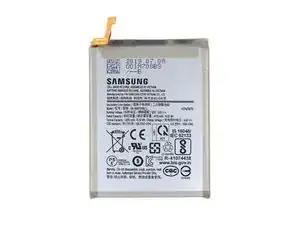





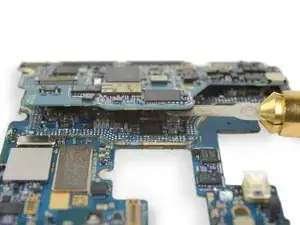





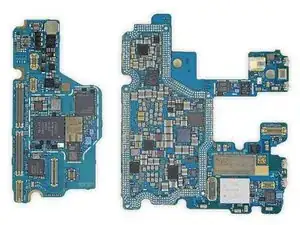





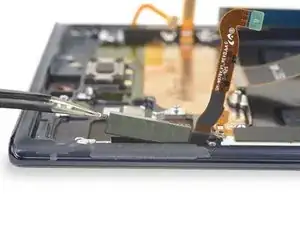


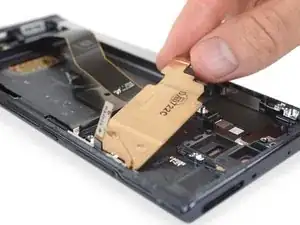

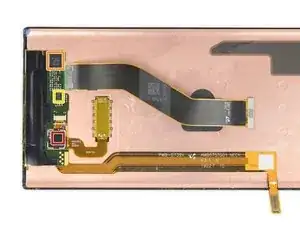







There is space for a pen, but not a headphone jack?
LOL!
Patrik Floding -